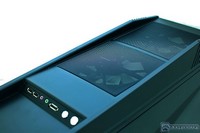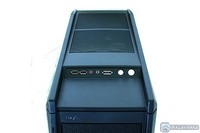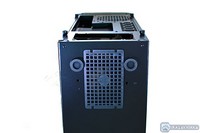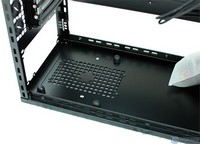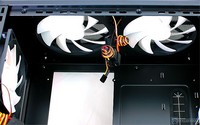Revised with cable management options, a black interior and a smoked side acrylic window, we review NZXT’s Tempest EVO case to see what makes this better than the original.
INTRODUCTION
If you are familiar with gaming cases then names like Antec, Thermaltake, and Cooler Master should be no surprise to your computer hardware vocabulary. One name that should be added to your case vocabulary is NZXT. NZXT is a newcomer to the gaming enthusiast market when compared to companies such as Antec and Thermtaltake, but what NZXT brings to the table is nothing different than what Antec, Thermaltake and Cooler Master bring: affordable quality cases.

With the step forward in cooling the Antec 900 case brought to the scene, it’s hard to avoid its design and functionality. NZXT capitalized on the design with a very similar case called the Tempest. Aside from looking similar aesthetically, the airflow design was also replicated with two 120MM fans on the front, one on the rear, and one on the side. The major difference between the Antec 900 and NZXT Tempest is the fan choice on the top. Antec went with a big 200MM fan while NZXT went with two 140MM fans. Aside from that, they are almost identical. The only thing left to consider is price. Choosing between the two comes down to brand loyalty and pricing.
Packaging
To be honest, I wasn’t very hopeful when our review sample arrived at my home. First off, the UPS person decided to leave the box in my backyard without any notice of the package being delivered. It wasn’t until my dog began barking frantically in the backyard did I realize the case arrived (He doesn’t like boxes in his yard). Secondly, the box looked like Hulk Hogan body slammed it.
Like many cases that we review from NZXT, the Tempest EVO came packaged in very thick cardboard and was also protected by thick foam. Fortunately for us, the cardboard and foam protected the Tempest EVO from any damage the UPS person tried to inflict on their “postal” like rampage on the box. Considering what our review sample went through, we highly doubt your new Tempest EVO will be beaten to smithereens thanks to the packaging methods NZXT uses. Props to NZXT for using stout packaging!
Specifications & Features
- Model – Tempest Series MID Tower
- Front Panel Material – Plastic
- Dimensions (W x H x D) – 211.5mm x 521.5mm x 562mm
- Cooling System
– FRONT – 2x120mm Blue LED Fans
– REAR – 1x120mm Fan
– SIDE PANEL – 1x120mm Blue LED Fan
– TOP – 2x140mm Fans - Expansion Bays
– Optical Drive Bays – 3
– External 5.25″ Drive Bays – 4
– Internal 3.5″ Drive Bays – 7 - Case Material – Steel
- Expansion Slots – 7
- Power Supply – Not Included
- Weight – 11.2 KGS
- Motherboard Support – ATX, Micro ATX, and Baby AT
Supporting up to 7 hard drives, 3 optical drives and 7 expansion cards, the Tempest EVO has plenty of room for growth when multiple drives and video cards come into play. The two front 120mm fans and one side panel 120mm fan give the Tempest EVO plenty of inbound air while the rear 120mm fan and two upper 140mm fans help the Tempest EVO exhale. There is no doubt that the Tempest EVO has plenty of airflow to keep components properly ventilated.
Pictures & IMPRESSIONS
Once out of its packaging, we met the NZXT Tempest EVO. Although the case is new from NZXT, the design is very familiar. The original Tempest used the same design minus additional cable management options and interior paint. Also, let’s not forget the uncanny Antec Nine Hundred resemblance.
The front of the Tempest EVO is full of wire mesh. The mesh allows the two 120mm fans to pull in air with ease. The same holds true for the top of the case where two 140mm fans exhaust hot air from the CPU and MOSFET areas. The back of the case has four water cooling holes all of which allow 1/2 inch tubing if required. The rear of the case also has a 120mm exhaust fan that helps exhaust the hot air within. To maximize airflow, the Tempest EVO also has mesh expansion slot covers instead of traditional steel covers. Not even the power supply is left out when it comes to available air flow. Under the case, NZXT put a mesh cover which gives the power supply a fresh supply of air.

All of the mesh covers (excluding the expansion slots) come with removable washable filters. The filters keep everything but air from entering the case. As long as the filters are cleaned periodically, everything within the Tempest EVO should remain fairly clean.
With the side panels removed, the interior differences between the original Tempest and the EVO are clearly visible. The all black interior adds to the overall black theme of the EVO. This adds a more sleek feel to the inside of the case. The additional cable management grommets allow for a tidy inside which helps rid of any air flow restrictions that cables may cause. The best thing we like about the design of the Tempest EVO is the “CPU punchout”. The “CPU punchout” allows for easy removal and installation of heatsinks or water blocks that require back plates. Installing the very huge Noctua NH-D14 heatsink was a breeze to say the least.
All of the fans within the EVO are powered by either a 4-pin Molex connector or a standard 3-pin connector. If your motherboard lacks 3-pin fan power, you can always resort to daisy chaining the connectors. We resorted to daisy chaining both front 120mm fans and the side panel 120mm fan to minimize cable clutter but it really comes down to preference and power limitations.
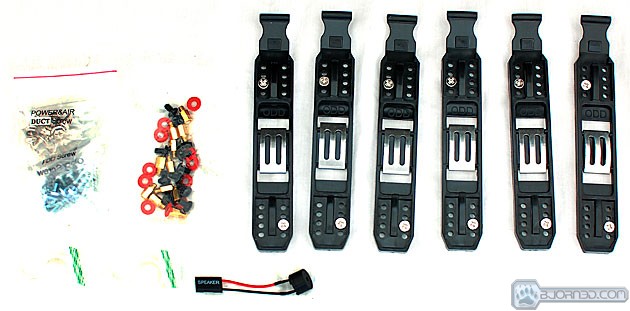
Within the accessories box there were optical drive rails, screws, motherboard mounting hardware, additional cable management adhesive clips, and a mini speaker. The Tempest EVO also came with hard drive rails which are hard to spot in our pictures. NZXT put the hard drive rails inside the hard drive bays, all 16 of them.
Another hard to spot feature in the EVO is the 5.25″ to 3.5″ adapter that allows another hard drive, floppy drive or media card reader.
In the bottom of the case is where the power supply is mounted. This makes routing cables easier and also makes room for massive heatsinks to cool those very toasty quad core processors. Unfortunately for us, our review sample was missing one of the four power supply stands. (If you do encounter this issue, contact NZXT and we’re sure they will happily get that resolved).
The inside top of the case gives you a clear view of the beefy (yet quiet) 140MM fans. Another very cool feature to the Tempest EVO is the ability to mount a 2x120mm radiator to the top of the case. If you currently have a water cooling loop or are planning one, the Tempest EVO has plenty of room to house a kit of the proper size. With all the fans in the front, top, side, and rear, there is plenty of airflow to keep temperatures under control, water cooling or not.
Testing & Methodology
| Test Rig “Station_i7” |
|
| Case Type | NZXT Tempest EVO |
| CPU | Core i7 920 @ 4.0GHz (HyperThreading Enabled) |
| Motherboard |
ASUS P6T Deluxe V2 |
| Memory |
Kingston HyperX DDR3 200MHz 3GB Kit @ 1800MHz |
| CPU Cooler | Noctua NH-D14 |
| Hard Drives | Western Digital Raptor 74GB 10,000RPM Seagate Barracuda 7,200 RPM |
| Optical | Samsung DVD R/W |
| GPU(s) | XFX 4870X2 |
| PSU | Topower Tiger Series 1200W |
| Mouse | Razer DeathAdder |
| Keyboard | Logitech Illuminated |
| Sound Card | Creative X-Fi Xtreme Gamer |
| *** Any attempt copy this system configuration may lead to awesomeness. |
|
|
Software Used |
|
Furutremark 3DMark Vantage |
To test the temperatures in the Tempest EVO we used HWMonitor to record temperatures and Futuremark 3DMark Vantage (with all default settings) to stress the hardware. We ran 3DMark Vantage a total of three times to fully stress the machine and get everything nice and toasty. Due to the CPU being a quad core CPU, we averaged the CPU temperatures in our charts. Along with the CPU temperatures, we recorded the GPU, system, and hard drive temperatures. Before moving onto the results, here are two pics of the case fully assembled with all the hardware installed.
From the pictures above you can get a clear idea of what the Tempest EVO is capable is housing. The 4870X2 is a monster of a card and the Noctua NH-D14 CPU cooler is beyond huge. Both fit without any issues. The backside picture shows you just how easy it is to install and remove backplates and manage cables. It’s about time a case manufacture gave us some room for those backplates! Thank you NZXT! On to the results!
RESULTS

Before going over the temperature results we wanted to point out something that every case review should disclose, temperature variations. Depending on the time of day and season/weather, temperatures will vary greatly. Because we don’t have a special room with a precise temperature that never changes, we don’t like comparing cases to other cases for the sake of overall fairness. Now that we’ve covered that topic, lets go over the results.
An i7 920 overclocked to 4GHz usually requires a hefty increase in voltage to maintain stability. Fortunately for us, our 920 requires only 1.32v to hold 100% stability. Combined with the Noctua NH-D14 heatsink, our 920 is in air cooled heaven. With an idle temperature of 44C and a max temperature of 71C, there is no doubt that the Tempest EVO is producing plenty of airflow allowing the case to breathe. This proves true when we look at the motherboard temperatures. The motherboard stayed right with the processor and video card with an idle temperature of 43C. With all the air circulating through the case, the motherboard socket area stayed at only 55C during load.
Thanks to the two front fans and side panel fan, the hard drives and 4870X2 video card stayed fairly cool as well. The 4870X2 itself is capable is heating up an entire case. With two GPU’s on board, the 4870X2 can get very hot. With the fan speed set at 45% on the card, the Tempest EVO kept the idle temperature at a decent 41.5C and the load temperature at a very respectable 77.5C. If you happen to own a 4870X2 you would definitely appreciate these temperatures. One surprising thing we noticed about this case was its ability to keep the hard drives temperatures completely isolated. Even though the toasty 4870X2 and i7 920 were dishing out heat, the hard drives stayed at 35C idle and only rose 2C during load to 37C.
Looking at the results, we are nothing but impressed. The Tempest EVO has a great design that is obviously producing functional airflow.
Conclusion
In my personal opinion, this case is the new business. It cools very well, it looks fantastic, and it has plenty of room for upgrades. Either it be water cooling or a monster heatsink like the NH-D14 from Noctua, the Tempest EVO is capable of handling it.

NZXT seems to have covered everything with this case. Aesthetics? Check. Function? Check. Upgrade capable? Check. Cable management? Check. Fan filters that can be easily removed and cleaned? Check. The list goes on, even down to pricing. At $119 with a $20 mail in rebate, the Tempest EVO is a clear crown stealer even next to the almighty Antec Nine Hundred Two.
| OUR VERDICT: NZXT Tempest EVO | ||||||||||||||||||
|
||||||||||||||||||
| Summary: The Tempest EVO from NZXT is an affordable case that is both functional and aesthetically charming. With its cable management options, upgrade options, and better than normal performance, theres no reason this case shouldn’t be on you’re next upgrade list. |
 Bjorn3D.com Bjorn3d.com – Satisfying Your Daily Tech Cravings Since 1996
Bjorn3D.com Bjorn3d.com – Satisfying Your Daily Tech Cravings Since 1996






